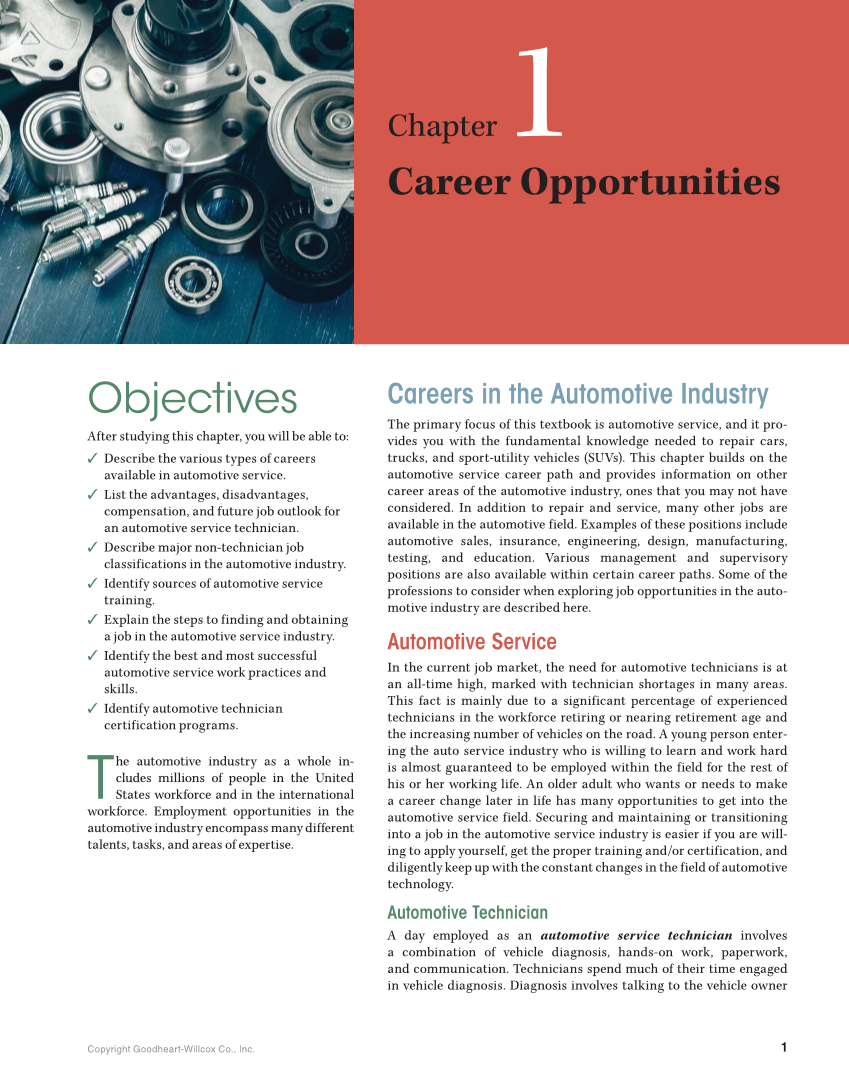Copyright Goodheart-Willcox Co., Inc. 1 Chapter 1 Career Opportunities Objectives After studying this chapter, you will be able to: ✓ Describe the various types of careers available in automotive service. ✓ List the advantages, disadvantages, compensation, and future job outlook for an automotive service technician. ✓ Describe major non-technician job classifications in the automotive industry. ✓ Identify sources of automotive service training. ✓ Explain the steps to finding and obtaining a job in the automotive service industry. ✓ Identify the best and most successful automotive service work practices and skills. ✓ Identify automotive technician certification programs. T he automotive industry as a whole in- cludes millions of people in the United States workforce and in the international workforce. Employment opportunities in the automotive industry encompass many different talents, tasks, and areas of expertise. Careers in the Automotive Industry The primary focus of this textbook is automotive service, and it pro- vides you with the fundamental knowledge needed to repair cars, trucks, and sport-utility vehicles (SUVs). This chapter builds on the automotive service career path and provides information on other career areas of the automotive industry, ones that you may not have considered. In addition to repair and service, many other jobs are available in the automotive field. Examples of these positions include automotive sales, insurance, engineering, design, manufacturing, testing, and education. Various management and supervisory positions are also available within certain career paths. Some of the professions to consider when exploring job opportunities in the auto- motive industry are described here. Automotive Service In the current job market, the need for automotive technicians is at an all-time high, marked with technician shortages in many areas. This fact is mainly due to a significant percentage of experienced technicians in the workforce retiring or nearing retirement age and the increasing number of vehicles on the road. A young person enter- ing the auto service industry who is willing to learn and work hard is almost guaranteed to be employed within the field for the rest of his or her working life. An older adult who wants or needs to make a career change later in life has many opportunities to get into the automotive service field. Securing and maintaining or transitioning into a job in the automotive service industry is easier if you are will- ing to apply yourself, get the proper training and/or certification, and diligently keep up with the constant changes in the field of automotive technology. Automotive Technician A day employed as an automotive service technician involves a combination of vehicle diagnosis, hands-on work, paperwork, and communication. Technicians spend much of their time engaged in vehicle diagnosis. Diagnosis involves talking to the vehicle owner
